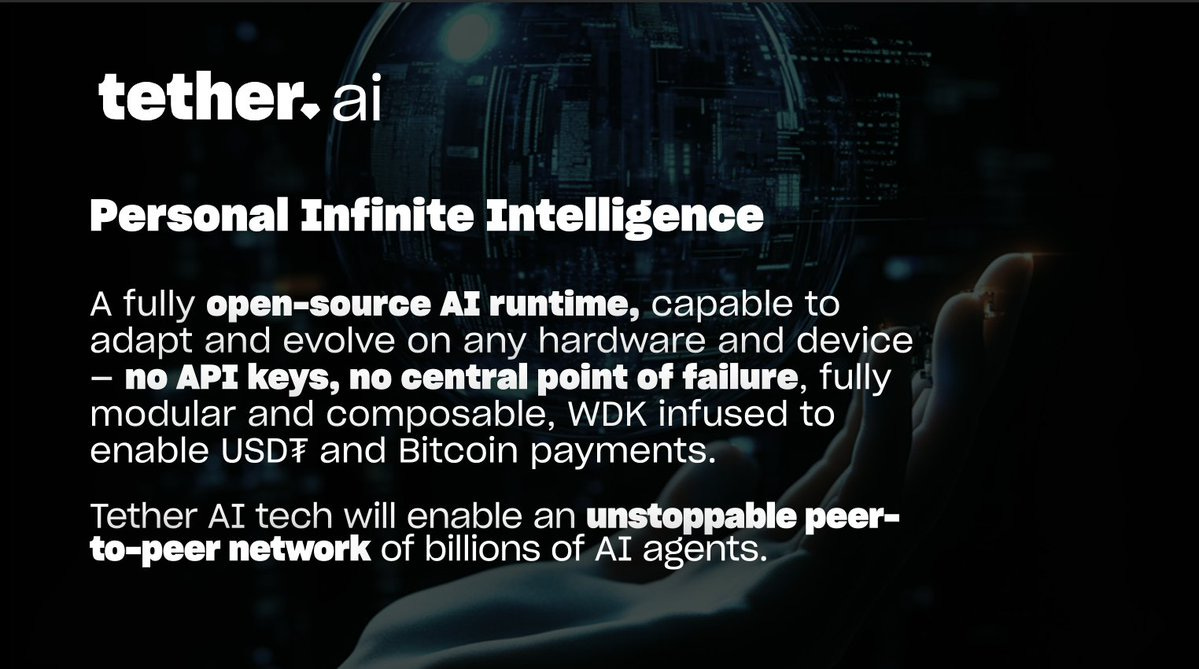Tether AI and the Dawn of Peer-2-Peer Intelligence
This Is Why They Win....
The launch of Tether AI is the next signal in a broader thesis. Tether isn’t building products, it’s just adding to a digital sovereign stack; one that increasingly looks unstoppable.
Paolo Ardoino’s announcement of “tether.ai” introduces a new kind of AI runtime: open-source, decentralized, modular, and natively integrated with USDT and Bitcoin payments via Tether’s Wallet Development Kit (WDK).
On paper? It’s an AI platform.
In reality? It’s a statement of intent: Tether wants to win the race for infrastructure; money, messaging, mobility, and now intelligence.
What Is Tether AI?
According to Ardoino, Tether AI’s “Personal Infinite Intelligence” is a:
Fully open-source AI runtime
Able to run on any hardware or device
No API keys, no central point of failure
Modular and composable by design
Powered by WDK for native Bitcoin and USDT payments
The aim is to create an “unstoppable peer-to-peer network of billions of AI agents.” That’s not marketing fluff; that’s protocol-level ambition.
More than “just” deploying machine learning tools, tether.ai is about decentralizing intelligence in the same way Bitcoin decentralized trust.
Why It Matters: The Strategic Implications
Tether’s roadmap is starting to make a lot more sense when you zoom out:
USDT - Dollar liquidity rails
XAUt - Gold-backed hedge for store-of-value believers
WDK - Developer stack for wallet infrastructure
OCEAN - Bitcoin mining decentralization
Tether Energy - Sustainable compute and power
Tether AI - Intelligence at the edge, uncensored and peer-to-peer
What binds it all? Sovereignty. Self-custody. Global access. Minimal gatekeeping.
Tether is stitching together a permissionless infrastructure stack. From stablecoins to tokenized gold, from open-source wallets to decentralized mining, and now a modular AI runtime, each component serves the same underlying mission: putting power back into users’ hands.
Sovereignty means owning your money, your data, your identity. Self-custody means no banks, no backdoors, no dependence. Global access means a street vendor in Lagos and a developer in Hanoi are using the same rails. And minimal gatekeeping means no KYC fortress standing between you and basic financial tools.
With Tether AI, they’ve just added another layer of tooling for builders. But this time, it’s not about finance (at first sight).
And it’s another clear differentiator from Circle or Coinbase. Those companies are still trying to get permission. Tether is building parallel systems.
This Is Why They Win
Tether gets memetics. They get latency. They ship fast and often, and they’ve leaned into markets others ignored. Lesson learned for perma fudders talking about MiCAH and the implications for USDT. The EU wants compliant, audit-tracked stablecoins, and that’s fine, for the EU. But Tether didn’t build its empire on regulatory appeasement. It was built by solving problems for real users. Skipping MiCA registration wasn’t a blunder. It was a signal. Europe is not the center of gravity in crypto anymore, and Tether knows it. When you’re the base layer of liquidity for emerging markets, black markets, and frontier economies, Brussels isn’t your top priority.
And btw, this AI runtime may not compete with OpenAI on raw capability (yet), but it doesn’t need to. It competes on access, ethos, and alignment with crypto-native users.
If your AI agent can live anywhere, speak to anyone, swap stablecoins, and run without permission, who needs Silicon Valley?
I’ve followed Tether long enough to know that every launch is part of a longer game. As the usual suspects, they’re building a stack for the unbanked, and the uninvited.
The few…..
Freedom Tech Is Awesome
The idea of AI agents tied to peer-to-peer finance, running across modular runtimes, and deployed anywhere in the world might seem far-fetched. But the idea of a stablecoin becoming the largest issuer of U.S. Treasuries once seemed far-fetched too.
Tether doesn’t play by the rules because it doesn’t need to. Maybe that’s why I like them so much. They play to win. And with tether.ai, they’re now playing on the terrain of intelligence itself.
If you’re betting on freedom tech in the coming decade, you could do worse than follow the team shipping at Tether.
I love stablecoins, Tether in particular, and I will be writing about the ongoing and ever-increasing future stablecoin war. Stay tuned for insights, drama, and analysis as it all unfolds.
P.S. In case you didn’t realize, I am not Patrick Hansen


